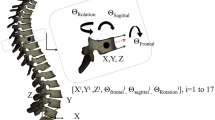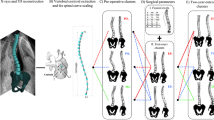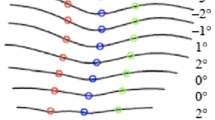Abstract
Purpose
Understanding how to classify and quantify three-dimensional (3D) spinal deformities remains an open question in adolescent idiopathic scoliosis. The objective of this study was to perform a 3D manifold characterization of scoliotic spines demonstrating thoracic deformations using a novel geometric and intuitive statistical tool to determine patterns in pathological cases.
Methods
Personalized 3D reconstructions of thoracic (T)/lumbar (L) spines from a cohort of 170 Lenke Type-1 patients were analyzed with a non-linear manifold embedding algorithm in order to reduce the high-dimensionality of the data, using statistical properties of neighbouring spine models. We extracted sub-groups of the data from the underlying manifold structure using an unsupervised clustering algorithm to understand the inherent distribution and determine classes of pathologies which appear from the low-dimensional space.
Results
For Lenke Type-1 patients, four clusters were detected from the low-dimensional manifold of 3D models: (1) normal kyphosis (T) with hyper-lordosis (L) and high Cobb angles (37 cases), (2) low kyphosis (T) and normal lordosis (L), with high rotation of plane of maximum curvature (55 cases), (3) hypo-kyphotic (T) and hyper-lordosis (L) (21 cases) and (4) hyper-kyphotic (T) with strong vertebral rotation (57 cases). Results show the manifold representation can potentially be useful for classification of 3D spinal pathologies such as idiopathic scoliosis and serve as a tool for understanding the progression of deformities in longitudinal studies.
Conclusions
Quantitative evaluation illustrates that the complex space of spine variability can be modeled by a low-dimensional manifold and shows the existence of an additional hyper-kyphotic subgroup from the cohort of 3D spine reconstructions of Lenke Type-1 patients when compared with previous findings on the 3D classification of spinal deformities.








Similar content being viewed by others
References
Clin J, Aubin CE, Parent S et al (2010) Comparison of the biomechanical 3D efficiency of different brace designs for the treatment of scoliosis using a finite element model. Eur Spine J 19:1169–1178
Kadoury S, Cheriet F, Beauséjour M et al (2009) A three-dimensional retrospective analysis of the evolution of spinal instrumentation for the correction of adolescent idiopathic scoliosis. Eur Spine J 18:23–37
Villemure I, Aubin CE, Grimard G et al. (2001) Progression of vertebral and spinal three-dimensional deformities in adolescent idiopathic scoliosis: a longitudinal study. Spine 2226–2244
Kadoury S, Cheriet F, Laporte C et al (2007) A versatile 3D reconstruction system of the spine and pelvis for clinical assessment of spinal deformities. Med Biol Eng Comput 45:591–602
Carpineta L, Labelle H (2003) Evidence of three-dimensional variability in scoliotic curves. Clin Orthop Relat Res 412:139–148
King HA, Moe JH, Bradford DS et al (1983) The selection of fusion levels in thoracic idiopathic scoliosis. J Bone Joint Surg 65:1302–1313
Lenke LG, Betz RR, Bridwell KH et al (1998) Intraobserver and interobserver reliability of the classification of thoracic adolescent idiopathic scoliois. J Bone Joint Surg 80A:1097–1106
Lenke LG, Betz RR, Harms J et al (2001) Adolescent idiopathic scoliosis: a new classification to determine extent of spinal arthrodesis. J Bone Joint Surg 83:1169–1181
Cil A, Pekmezci M, Yazici M et al (2005) The validity of Lenke criteria for defining structural proximal thoracic curves in patients with adolescent idiopathic scoliosis. Spine 30:2550–2555
D’Andrea LP, Betz RR, Lenke LG et al (2000) Do radiographic parameters correlate with clinical outcomes in adolescent idiopathic scoliosis. Spine 25:1795–1802
Stokes IA, Bigalow LC, Moreland MS (1987) Three-dimensional spinal curvature in idiopathic scoliosis. J Orthop Res 5:102–113
Poncet P, Dansereau J, Labelle H (2001) Geometric torsion in idiopathic scoliosis: three-dimensional analysis and proposal for a new classification. Spine 26:2235–2243
Duong L, Cheriet F, Labelle H (2006) Three-dimensional classification of spinal deformities using fuzzy clustering. Spine 31:923–930
Sangole A, Aubin CE, Labelle H et al (2009) 3D classification of thoracic scoliotic curves. Spine 34:91–99
Cootes T, Edwards G, Taylor C (2001) Active appearance models. IEEE Trans Patt Anal Mach Intel 23:681–685
Roweis ST, Saul LK (2000) Nonlinear dimensionality reduction by locally linear embedding. Science 290:2323–2326
Kadoury S, Cheriet F (2006) X-ray image restoration with adaptive PDE filter for an accurate 3D reconstruction of the human spine. In: Proceedings of International Conference on Computer Assisted Radiology and Surgery 470
Kadoury S, Cheriet F, Labelle H (2009) Personalized X-ray 3D re construction of the scoliotic spine from statistical and image models. IEEE Trans Med Imag 28:1422–1435
Boisvert J, Cheriet F, Pennec X et al (2008) Geometric variability of the scoliotic spine using statistics on articulated shape models. IEEE Trans Med Imag 27:557–568
Ray S, Turi RH (1999) Determination of number of clusters in K-means clustering and application in colour image segmentation. In: Proceedings of Conference on Advances in Pattern Recognition and Digital Techniques 137–143
Stokes IA, Bigalow LC, Moreland MS (1986) Measurement of axial rotation of vertebrae in scoliosis. Spine 11:213–218
Stokes IA (1994) Three-dimensional terminology of spinal deformity. A report presented to the Scoliosis Research Society by the Scoliosis Research Society Working Group on 3D terminology of spinal deformity. Spine 19:236–248
Perdriolle R, Le Borgne P, Dansereau J et al (2001) Idiopathic scoliosis in three dimensions: a succession of two-dimensional deformities? Spine 26:2719–2726
Vrtovec T, Vengust R, Likar B et al (2010) Analysis of four manual and a computerized method for measuring axial vertebral rotation in computed tomography images. Spine 20:E535–E541
Vrtovec T, Ourselin S, Gomes L et al (2007) Automated generation of curved planar reformations from MR images of the spine. Phy Med Biol 52:2865–2878
Conflict of interest
None.
Author information
Authors and Affiliations
Corresponding author
Additional information
This paper was supported in part by a grant from the Fonds Québecois de la Recherche sur la Nature et les Technologies (FQRNT) and funds from the Scoliosis Research Society.
Rights and permissions
About this article
Cite this article
Kadoury, S., Labelle, H. Classification of three-dimensional thoracic deformities in adolescent idiopathic scoliosis from a multivariate analysis. Eur Spine J 21, 40–49 (2012). https://doi.org/10.1007/s00586-011-2004-2
Received:
Revised:
Accepted:
Published:
Issue Date:
DOI: https://doi.org/10.1007/s00586-011-2004-2




